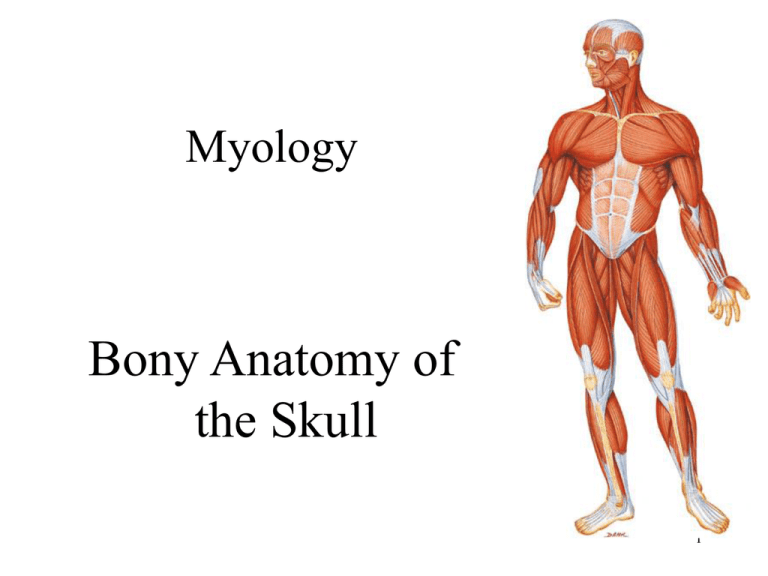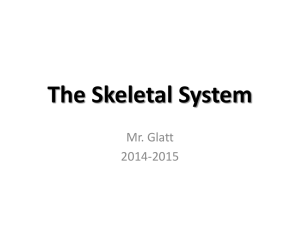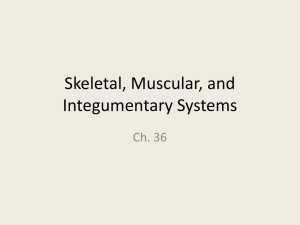02 – Bony Anatomy of the Skull
advertisement

Myology Bony Anatomy of the Skull 1 Bone Surface Markings • Depressions and openings: • Processes for tendon and ligament attachment: – Fissure: narrow opening between – – – – adjacent parts of bones for nerves and vessels Foramen: hole, opening Fossa: shallow depression Sulcus: groove Meatus: tubelike passageway • Processes that form joints – Condyle: large rounded prominence – Facet: smooth flat surface – Head: rounded articular projection – Crest: prominent border or ridge – Epicondyle: prominence above a condyle – Linea: line, less prominent than a crest – Trochanter: large projection of bone found only on the femur – Tubercle: small rounded process – Tuberosity: large, rounded, usually roughened process 2 Gross Anatomy Osteology of the Skull: Cranium 3 Skull • Cranium: Consists of 8 bones – – – – – – (1) Frontal Bone (2) Temporal Bones (2) Parietal Bones (1) Occipital Bone (1) Sphenoid Bone (1) Ethmoid Bone • Face: Consists of 14 bones (Studied in lecture 2) – – – – – – – – (2) Maxilla (2) Zygomatic bones (2) Lacrimal bones (2) Palatine bones (2) Nasal bones (2) Inferior nasal conchae (1) Vomer (1) Mandible 4 Bones of the Cranium 5 Frontal Bone 6 Frontal Bone • The large bone that makes up the forehead and supplies the upper edge and roof of the orbit (eye socket). • The frontal bone articulates (comes together) with a number of other bones including the parietal, nasal, ethmoid, maxillary, and zygomatic bones. • Landmarks: – Squama: flat portion that forms the forehead – Supraorbital margin: ridge under the eyebrow, forming the upper part of the orbit (eye socket) – Supraorbital foramen: small hole within supraorbital margin for blood vessels and nerves – Frontal sinuses: hollow spaces behind the squama, act as sound chambers to give the voice resonance. 7 Frontal Bone (Anterior View) (Blue Colored Bone) 8 Frontal Bone (Lateral View) (Blue Colored Bone) 9 Temporal Bones 10 Temporal Bones • A large irregular bone situated at the base and side of the skull. The temporal bone is connected with the mandible (the jaw bone) via the temporomandibular (TM) joint. • The temporal bone is formed of three parts (squamous, tympanic and petrous) that are distinct at birth but then fuse. The petrous portion of the temporal bone contains the structures of the inner ear. • Landmarks: – Squama: flat portion of the temporal bone forming the anterior and superior part of the temple – Zygomatic process: process forming part of the cheek – Petrous portion: internal, forming part of the floor of the cranium. Contains the ear canal and internal ear structures. – Mandibular fossa: socket between squama and petrous portion, articulates with the condyle of the mandible (TMJ) – External auditory meatus: opening to the ear canal – Mastoid process: bony prominence behind the external auditory meatus – Styloid process: looks like an elephant’s tusk located between the mastoid process and the jaw. Acts as a point of attachment for muscles and ligaments. 11 Temporal Bone (Lateral View) (Purple Colored Bone) 12 Parietal Bones • The main bone on the side of the skull. • The word "parietal" comes from the Latin "parietalis" meaning "belonging to the wall." • It articulates (joins) with the other parietal bone in the midline (top of the head), with the frontal bone in front of it, with the occipital bone behind it, and with the sphenoid and temporal bones lower down on the side of the skull. 13 Parietal Bone (Lateral View) (Red Colored Bone) 14 Occiput 15 Occiput • From the Latin, meaning the part of the head opposite the front. • The bone that forms the rear and the rear bottom of the skull. • The occipital bone articulates (joins) with the parietal and temporal bones of the skull, the sphenoid bone in front of it, and the first cervical vertebra (the atlas) beneath it • Landmarks: – Foramen magnum: large hole, allowing passage of the spinal cord – External occipital protuberance (EOP): prominent projection on back of occiput – Nuchal lines: a superior and inferior line running laterally from the midline, serve as a point of muscle attachment 16 Occipital Bone (Posterior View) (Orange Colored Bone) 17 Occipital Bone (Lateral View) (Orange Bone) 18 Sphenoid Bone 19 Sphenoid Bone • A prominent, irregular, wedge-shaped bone at the base of the skull. The sphenoid bone has been called the "keystone" of the cranial floor since it is in contact with all of the other cranial bones. • The Greek physician Galan wrote that the sphenoid bone was "like a wedge thrust between the skull and the superior maxilla." • Landmarks – Greater wings: large lateral projections of bone that help to form the lateral border of the skull – Lesser wings: smaller lateral projections of bone above the greater wings – Pterygoid processes: two long downward projections from the greater wings that act as a point of muscle attachment. – Sella turcica: known as the Turkish Saddle which cradles the 20 pituitary gland. Sphenoid Bone (Lateral View) (Green Colored Bone) 21 Sphenoid Bone (Floor of Cranium) (Green Colored Bone) 22 Ethmoid Bone • An irregularly shaped, spongy bone that provides the floor of the front part of the skull and the roof of the nasal cavity. • The ethmoid consists of two masses of thin plates enclosing air cells and looks like a sieve. • Landmarks: – Lateral masses: form most of the wall between the nasal cavity and the orbits – Perpendicular plate: forms the superior portion of the nasal septum – Cribiform plate: forms the roof of the nasal cavity – Olfactory foramina: small holes within the cribiform plate for passage of the first cranial nerve (for smell) – Crista galli: upward extension of bone above the cribiform plate, acts as an anchoring point for one of the coverings of the brain. – Nasal concha (turbinates): two scroll-shaped projections with a mucus membrane on either side of the nasal septum. Function to cause air turbulence and trap inhaled particles. 23 24 Bones of the Face 25 Maxilla 26 Maxilla • • • • The largest bones of the face, except for the mandible and form, by their union, the whole of the upper jaw. They hold the upper teeth, and connect on the left and right to the zygomatic bones (cheek bones). Each assists in forming the boundaries of three cavities, namely, the roof of the mouth, the floor and lateral wall of the nose, and the floor of the orbit. Landmarks: – Infra Orbital foramen: hole below the orbit, for blood vessels and nerves – Alveolar process: arch of the maxilla containing the upper teeth – Palatine process: horizontal projection of the maxilla forming the anterior ¾ of the hard palate. 27 Maxilla (Anterior View) (Yellow Colored Bones) 28 Zygomatic Bones Commonly referred to as the cheekbone. It is situated at the upper and lateral part of the face: it forms the prominence of the cheek and part of the lateral wall and floor of the orbit. It articulates with the zygomatic arch of the temporal bone. 29 Zygomatic Bones (Anterior View) (Pink Colored Bones) 30 Lacrimal Bones Smallest and most fragile bone of the face, is situated at the front part of the Medial of the orbit. Lacrimal bone Contains the lacrimal sac and the nasolacrimal duct. 31 Lacrimal Bones (Anterior View) (Blue Colored Bones below frontal bone) 32 Palatine bones It contributes to the walls of three cavities: the floor and lateral wall of the nasal cavity, the roof of the mouth, and the floor of the orbit 33 Nasal Bones Varying in size and form in different individuals They are placed side by side at the middle and upper part of the face and form, by their junction, "the bridge" of the nose 34 Nasal Bones (Anterior View) (Bridge of the nose, below frontal bone) 35 Inferior Nasal Conchae Extends horizontally along the lateral wall of the nasal cavity and consists of a lamina of spongy bone, curled upon itself like a scroll. Inferior Nasal Conchae 36 Inferior Nasal Conchae (Anterior View) (Inside nasal cavity on lateral walls) 37 Vomer One of the unpaired facial bones of the skull. Located in the midsagittal line, and touches the sphenoid, the ethmoid, the left and right palatine bones, and the left and right maxillary bones. 38 Vomer (Anterior View) (Center wall in nasal cavity) 39 Mandible Largest and strongest bone of the face. Forms the lower jaw and holds the lower teeth in place. The mandible consists of a curved, horizontal portion, the body, and two perpendicular portions, the rami, which unite with the ends of the body nearly at right angles. 40 Mandible • Largest and strongest bone of the face. • Forms the lower jaw and holds the lower teeth in place. • Landmarks: – Body: curved horizontal portion of the mandible – Rami: two upward projections of bone that are perpendicular to the body of the mandible. – Angle of the mandible: angle formed where the body meets the ramus – Condylar process: a condyle on the posterior portion of the ramus that articulates with the mandibular fossa of the temporal bone. – Coronoid process: a sharp projection of bone on the anterior portion of the ramus that acts as a point of muscle attachment. – Alveolar process: arch of bone containing the lower teeth – Mental foramen: small hole on the side of the body for blood vessels and nerves. 41 Mandible (Anterior View) (Lower Jaw) 42 Mandible (Lateral View) (Lower Jaw) 43 Palpation of the Cranium Occiput: Prone; place hands on the back of the head between partner’s ears. Slide your fingers superiorly to the External Occipital Protuberance (EOP) two to three inches. Then slide fingers laterally to the mastoid process behind the ears. Superior Nuchal Lines: Prone or supine; locate the EOP and then slide your fingers laterally moving your fingerpads up and down feeling for the edge of the superior nuchal line. Parietal Bone: Prone or supine; place both hands on the top of the cranium. Palpate the sagittal suture between the parietals. From the suture, palpate the parietal bones down towards the ears Temporal Bone: Supine; locate the mastoid process by placing your fingers behind the ear lobe. The zygomatic arch can be palpated by placing your fingers anterior to the external auditory meatus. Palpate anteriorly along the arch with your finger and thumb. The flat squamous portion can be palpated superior to the mastoids and external auditory meatus. The styloid process can be palpated between the mandible and the mastoid process (palpate very gently) 44 Frontal bone: Supine; palpate the region of the forehead from the eyebrows up toward the coronal sutures Mandible: Supine: place your fingers inferior to the bottom teeth and palpate the body of the mandible. Move inferiorly and palpate the base of the mandible from the chin to the angle of the mandible. Then curl your fingertips underneath the edge to palpate the submandibular fossa. To palpate the angle of the mandible slide posterior alone the base of the mandible. The angle is located between the body and the ramus. To palpate the mandibular condyle place your finger anterior to the ear canal and below the zygomatic arch. Ask your partner to open his/her mouth fully, the condyle will protrude laterally and become more palpable. Nasal bones: Supine; locate the bridge of the nose Zygomatic bone: Supine, return to the zygomatic arch of the temporal bone and continue to move anteriorly until you reach the zygomatic (cheek) bone. Maxilla: Supine; palpate inferior to the zygomatic bone down to the mouth. The maxilla forms the center of the face. The alveolar processes can also be palpated where the teeth insert into the maxilla. 45







